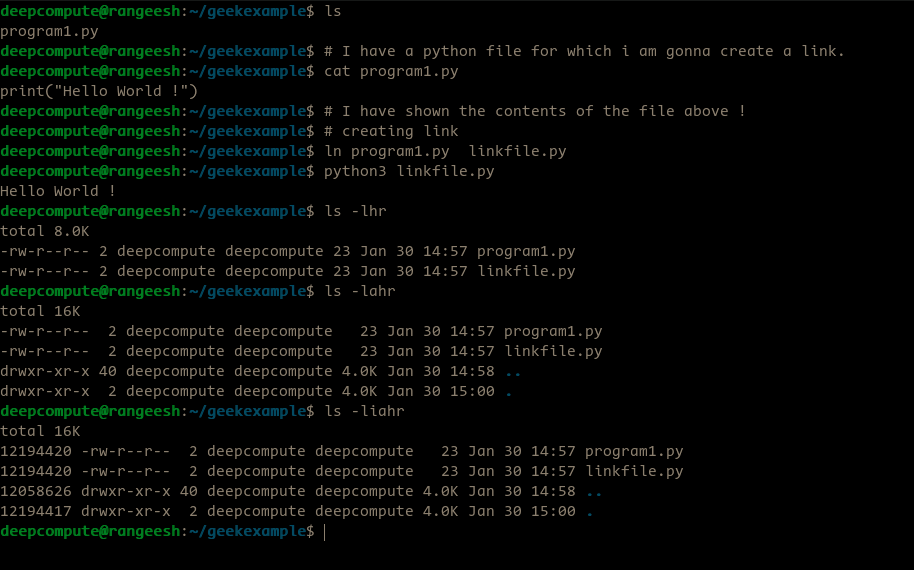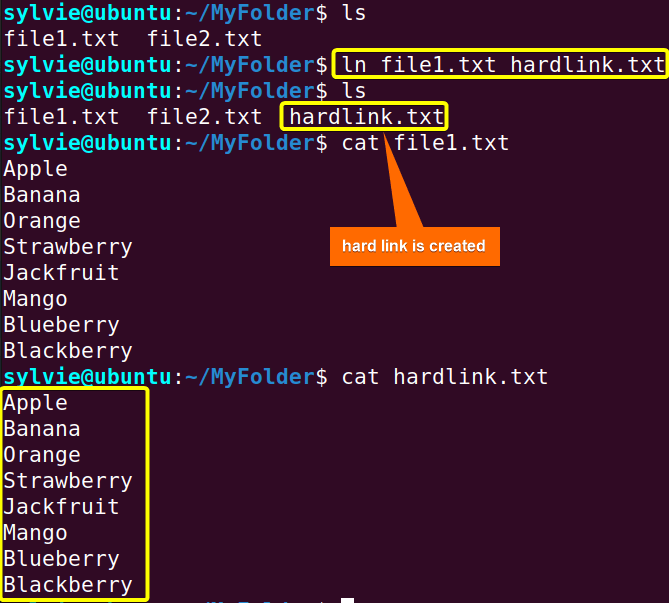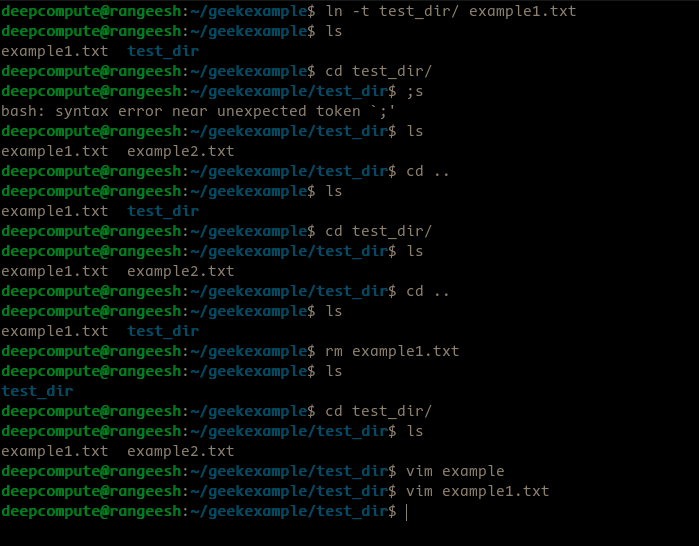
Linux ln Command Tutorial for Beginners (5 Examples)
What is the Linux ln command? The ln command is used to create links to files or directories. ("ln" is short for "link".) The command is given to the Linux command line (also called the shell), which can be opened and operated using a terminal window.

How to use Ln Command in Linux (Create Symbolic Links) Linux Tutorial Hub
How to Use the ln Command ln is a command-line utility for creating links between files. By default, the ln command creates hard links. To create a symbolic link, use the -s ( --symbolic) option. The ln command syntax for creating symbolic links is as follows: ln -s [OPTIONS] FILE LINK

Comando ln en Linux con ejemplos Barcelona Geeks
The script then uses the 'ln -s' command to create the symbolic link and echoes a confirmation message. Accompanying Commands. The 'ln' command often works in tandem with other Linux commands. For instance, the 'ls -l' command is commonly used to verify the creation of links. The 'rm' command can be used to remove.

Linux and Unix ln command tutorial with examples Ornbo
Basically, ln command is used to create hard links and soft links for files in Linux. Let's discuss all the three forms one by one. 1st Form: This form is simple, the source file with destination link name you have to specify:

How to Create a Link to a File or Directory Using ln Command ln Command in Linux YouTube
You use the ln command to create the links for the files and the -s option to specify that this will be a symbolic link. If you omit the -s option, then a hard link will be created instead. The existing_source_file represents the file on your computer that you want to create the symbolic link for.

LN Command Create Symbolic Links in Linux YouTube
The most popular use case for the ln command is creating the soft link. In order to create a soft link, we will use the -s or -symbolic option with the ln command. Then we will provide the source which can be a file and the link. In the following example, we will create a soft link for the file named myfile.txt with the name of mylink.
/6637412161_d5c06c3a31_b-577562355f9b5858759bffe8.jpg)
How to Create Symbolic Links Using the ln Command
November 5, 2018. A symbolic link, also know as symlink or soft link, is a special type of file that points to another file or directory. In this guide, we will cover how to use the ln command to create symbolic links. Complete Story. Previous article KDE has been deprecated in RHEL 7.6 and future version of RHEL.

Linux Ln Command Summary With Examples linux ln 최신
To make links between files you need to use ln command. A symbolic link (also known as a soft link or symlink) consists of a special type of file that serves as a reference to another file or directory. Unix/Linux like operating systems often uses symbolic links. This guide explains how to use the ln command to create symbolic/soft links.

How to Create Symbolic Links in Linux Using the LN Command SkillSugar
1. Create hard link to a file To create a hard link to a file, you can use the ln command without any options like this: ln target_file link_name 2. Create soft link to a file To create a symbolic link to a file, use the option -s with the target file name and the link name ln -s target_file link_name
/create-symbolic-links-ln-command-4059723-313abadeecf34c9eaf9f7e3603081b41.png)
How to Create Symbolic Links Using the ln Command
ln - make links between files SYNOPSIS top DESCRIPTION make hard links directly to symbolic links , create links relative to link location make symbolic links instead of hard links override the usual backup suffix specify the DIRECTORY in which to create the links --no-target-directory.

The “ln” Command in Linux [6 Practical Examples]
Note: If file2.txt is deleted or moved somewhere, the link will become a broken link. 3. Using "ln" Command to Create a Symbolic (Soft) Link to a Directory in Linux. To create a symbolic link to a directory, I am using the ln command with the -s option in Linux. Here I am showing how to create a link to the newfolder:. Enter the following command in the command prompt after opening your.

Comando ln en Linux con ejemplos Barcelona Geeks
In Linux, symbolic links, or symlinks, are a powerful tool for file management. They are essential in the file system, facilitating efficient file organization and streamlined workflows. This article will explain Linux symlinks and provide practical insights into creating and managing these special files.

ln command in Linux with Examples
1. Create a soft link using the ln command . To create a soft link, you'd have to use the -s flag with the ln command as shown: ln -s [target-file] [link-name] So let's say I want to create a soft link named MintLink for the file LinuxMint.iso located under /home/Test, the, I will be using the following: ln -s ~/Test/LinuxMint.iso MintLink

ln Command In Linux (Create Symbolic Links) LinuxTect
3. Using a Symlink. We can also change the timezone by symlinking the /etc/localtime directory to a timezone listed in the /usr/share/zoneinfo directory. This method can be useful for legacy Linux distros that don't have the timedatectl command available. Let's start by removing the current symlink: $ sudo rm -rf /etc/localtime.

How to Create Linux Symlinks Using the ln Command
Ln Command in Linux (Create Symbolic Links) A symbolic link, also known as a symlink or soft link, is a special type of file that points to another file or directory. In this guide, we will cover how to use the ln command to create symbolic links. Read more

How To Write Ln In
The ln command is a standard Unix command utility used to create a hard link or a symbolic link (symlink) to an existing file or directory. [1] The use of a hard link allows multiple filenames to be associated with the same file since a hard link points to the inode of a given file, the data of which is stored on disk.